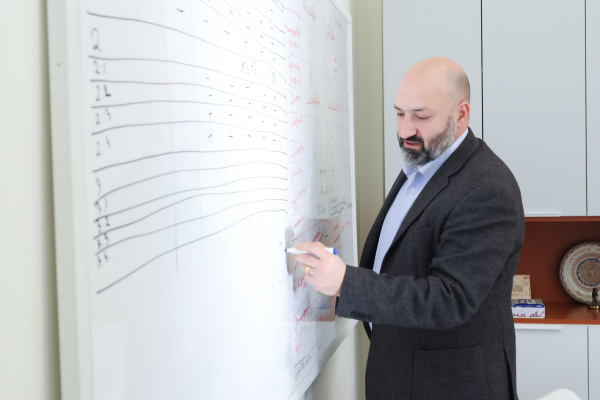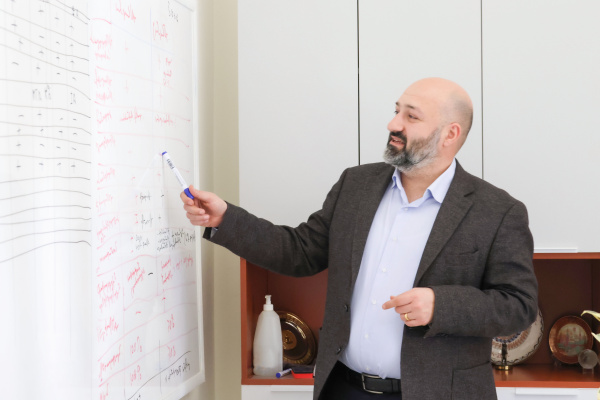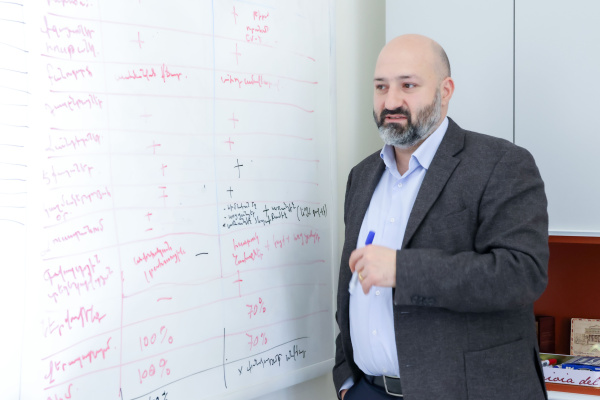January 22, 2025 | 14:00
Science
Education
From enhancing educational programs to integrating with the external environment: YSU introduces new strategic plan
A new strategic plan for 2025-2030 has been developed at Yerevan State University, emphasizing the need for human resource development, improvement of the management system, and systemic changes in the fields of education and science. In response to modern demands and global challenges, six new strategic goals have been developed. These goals were discussed with Mikayel Hovhannisyan, the university's Vice-Rector for Development and Innovation.

Throughout Armenia’s modern history, Yerevan State University has served as both the guardian and transmitter of the state's and society's institutional memory. It has also upheld and advanced the intellectual traditions of Armenian society, playing a key role in generating and spreading innovative ideas. Mikayel Hovhannisyan affirms this, emphasizing that the mission of YSU is to ensure the development of intellectual and human resources in Armenia by providing professional and civic knowledge and fostering the formation of skills and capabilities.
- Mr. Hovhannisyan, what factors led to the necessity of developing a new strategic plan?

- The need to develop the 2025-2030 strategic plan for Yerevan State University arose from several external and internal factors. Over the past two to three years, we have observed that while many steps have been taken within the framework of the current strategic plan, there are actions and results that cannot be fully assessed through the lens of this plan. Steps have been taken that were not yet outlined during the development of the strategy, which is to be expected, as that strategy was created in a different context and timeframe. Since then, both the university and the broader academic landscape, as well as the world at large, have undergone substantial changes. It became especially necessary to reinterpret and reassess the situation, leading to the formulation of a new conceptual approach, which was achieved through the new strategy. Secondly, due to intensive work, a significant portion of the targets defined by the strategic plan had already been achieved. Hence, the need for developing a new strategy emerged.
- What are the primary goals and principles of this strategic plan, and how do they relate to the university's long-term development?
- With the new strategy, we have formulated the "theory of change" for the university for the 2025-2030 period, a philosophy of operation that forms the basis of the strategy and describes the changes we aim to achieve and how we plan to implement them. The new strategic plan outlines the following change: to achieve high-quality education and research, the top priority must be the development and enhancement of human capital. Secondly, systemic changes must be implemented to ensure the efficiency of the decision-making process. Thirdly, the relevant structures and systems must be modernized to make the implementation of decisions more effective and institutional. Successfully solving these three problems creates a qualitatively new situation, which in turn allows for improving the content of educational programs and research outcomes. This, in turn, creates opportunities to establish new quality partnerships with the outside world, generating resources for entering the next phase, where these resources can again be directed toward addressing human capital development. This is a cyclical development logic.
Referring to the six goals, it is important to first note that the first two goals—modernizing the content and methodology of education, and improving research outcomes—are directed at the university's core functions. The first goal aims to improve educational programs by continuing the systemic changes that will make them more aligned with today's and, more broadly, the future's demands. The purpose of this approach is to effectively respond to labor market demands by making necessary changes in educational programs, making them more competitive and efficient.
Educational programs are also being improved thanks to changes made through the international accreditation process, aligning them with advanced global standards. Thus, the enhancement of educational program quality occurs not only through responding to local demands but also based on global standards, ensuring education of international caliber.

One of the key processes is the development and enhancement of the university's human resources and the modernization of its management system. This includes recruiting faculty members, supporting their professional advancement, organizing retraining programs, determining compensation structures, and clarifying shift arrangements. While this may seem like a technical process, it has a profound impact on the quality of educational services provided.
Modernizing the content and methodology of education is perhaps the largest, most complex, and most responsible part of the strategy, as the actions and goals related to the first strategic goal are closely interlinked with the other goals and often determine their content. In addition, the development of human resources is crucial, as it not only affects the quality of education but also significantly shapes the internal culture and capabilities of the university, which are necessary for long-term development.
Increasing the effectiveness of management is of primary importance for the implementation and effective realization of the strategy, as well as for organizing and promoting the university's normal operation and development. Finally, our sixth goal pertains to integration and harmonization with the external environment. Thus, our strategic goals are closely interconnected, and the entire strategic process is a system of interdependent components, where each goal complements the others.
- What innovations and changes are planned with the new strategic plan of Yerevan State University?
- In contrast to the previous strategic plan, which defined three strategic goals, this plan includes a certain level of specification. As a result of our evaluation, we determined that there are two very important functions that require targeted development at this stage of the university's development. These are the development of human resources and the improvement of the management system. For this reason, we have separated them into distinct goals, each with its own set of issues. If we can implement these two goals as we envision, we may return to the classic three strategic goals in the next phase. The difference lies in the emphasis and separation of these goals.

When an evaluation and development process reveals that something previously considered a tool is gradually becoming a goal, it should be formulated as a separate goal. This is important since it can affect both the organization of processes and the development of long-term strategies. In other words, having qualified staff is a means of organizing effective educational and research processes, but when the need for staff development is recognized, it is formulated as a separate goal.
- Mr. Hovhannisyan, what will be the first steps following the launch of this strategic plan? What actions are expected to be taken?
- Different actions are expected depending on the goal—ranging from education to relations with the outside world. I would describe the initial phase of the strategy's implementation as the formulation and testing of new tools based on adequately collected and analyzed information. It is important to note that, during the first three years, we will be actively engaged in these actions, so that in the second phase, we will be able to introduce the results in full scope.
- What is the vision of YSU? How do you envision the university in 5 years?
- The university’s vision is to effectively address current social, economic, and cultural issues at educational and research levels, while being integrated into the Armenian, regional, and global environments. Our expectation is that, as a result of implementing the plans outlined in the strategy, the current routine tasks will become more systematized and automated. Consequently, the university will become an institution where people will have more opportunities to focus on development rather than organizing routine processes. We also expect that, as a result of the implementation of these plans, the perception of the university's role and place within society will evolve and transform.

